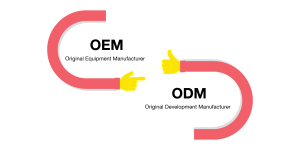Understanding OEM and ODM Manufacturing
In the world of manufacturing, OEM (Original Equipment Manufacturer) and ODM (Original Design Manufacturer) are two pivotal concepts that shape how products are brought to market. While they may seem similar at first glance, they represent distinct approaches, each with its own set of implications for businesses. Let’s unravel the essence of OEM and ODM manufacturing in a nutshell.
OEM Manufacturing: OEM manufacturing is when a manufacturer produces goods for a brand owner, who then sells them under their own brand name. The manufacturer manufactures the product according to the brand owner’s specifications. This setup enables brand owners to concentrate on marketing, sales, and distribution while leaving the production details to the manufacturer.
OEM manufacturing offers several benefits:-
Despite outsourcing manufacturing, brand owners maintain control over design, branding, and marketing, ensuring brand consistency. By leveraging OEM manufacturing expertise, brand owners cut production costs and boost profit margins. OEM arrangements allow brand owners to adjust production to meet market demand without managing manufacturing facilities or workforce. However, OEM manufacturing brings risks such as limited production process control, dependence on manufacturer capabilities, and supply chain issues.
ODM Manufacturing: ODM manufacturing offers full product development and manufacturing services to brand owners. Unlike OEM, where the brand owner provides specifications, in ODM, the manufacturer designs and develops the product based on market needs. Brand owners can customize the product to some extent before launching it.
ODM manufacturing offers several benefits:-
ODM manufacturing offers benefits in innovation, speed to market, and cost savings for brand owners. However, it presents challenges in intellectual property protection, as the manufacturer retains ownership of designs and technology, potentially leading to competition or replication by other brands.
Choosing the Right Manufacturing Strategy: Whether opting for OEM or ODM manufacturing, businesses must carefully evaluate their requirements, market dynamics, and long-term goals. Factors such as product complexity, brand identity, control over design and innovation, and risk tolerance play a crucial role in determining the most suitable manufacturing strategy.
OEM and ODM manufacturing offer distinct pathways for businesses to bring products to market efficiently and competitively. By understanding the nuances of these approaches and aligning them with their strategic objectives, companies can navigate the complexities of the manufacturing landscape and drive sustainable growth in today’s dynamic marketplace.
Author- Moumita Ghosh










Leave a Reply